Chicago Extreme Fire Behavior
Analysis of Fire Behavior Indicators
Quick Review
The previous post in this series presented a video clip of an incident on the afternoon of February 18, 2010 that injured four Chicago firefighters during operations at a residential fire at 4855 S. Paulina Street.
First arriving companies discovered a fire in the basement of a 1-1/2 story, wood frame, single family dwelling and initiated fire attack and horizontal ventilation of the floors above the fire. Based on news accounts, the company assigned to fire attack was in the stairwell and another firefighter was performing horizontal ventilation of the floors above the fire on Side C when a backdraft or smoke explosion occurred. Two firefighters on the interior, on at the doorway and the firefighter on the ladder on Side C were injured and were transported to local hospitals for burns and possible airway injuries.
In analyzing the video clip shot from inside a nearby building, we have several advantages over the firefighters involved in this incident.
Time: We are not under pressure to make a decision or take action.
Reduced Cognitive Workload: Unlike the firefighters who needed to not only read the fire, but also to attend to their assigned tactics and tasks, our only focus is analysis of the fire behavior indicators to determine what (if any) clues to the potential for extreme fire behavior may have been present.
Repetition: Real life does not have time outs or instant replay. However, our analysis of the video can take advantage of our ability to pause, and replay key segments, or the entire clip as necessary.
Perspective: Since the field of view in the video clip is limited by the window and the fidelity of the recording is less than that seen in real life, it presents a considerably different field of view than that of the firefighters observed in operation and does not allow observation of fire behavior indicators and tactical operations on Sides A, B, and D.
Initial Size-Up
What B-SAHF indicators could be observed on Side C up to the point where firefighters began to force entry and ventilate the basement (approximately 02:05)?
Figure 1. Conditions at 01:57 Minutes Elapsed Time in the Video Clip

Building: The structure is a 1-1/2 story, wood frame, dwelling with a daylight basement. The apparent age of the structure makes balloon frame construction likely, and the half story on the second floor is likely to have knee walls, resulting in significant void spaces on either side and a smaller void space above the ceiling on Floor 2. One window to the left of the door on Side C appears to be covered with plywood (or similar material). Given the location of the door (and door on Side A illustrated in the previous post in this series), it is likely that the stairway to the basement is just inside the door in Side C and a stairway to Floor 2 is just inside the door on Side A.
Smoke: A moderate volume of dark gray smoke is visible from the Basement windows and windows and door on Floor 1 as well as a larger volume from above the roofline on Side B. While dark, smoke on Side C does not appear to be thick (optically dense), possibly due to limited volume and concentration while smoke above the roofline on Side B appears to be thicker. However smoke on Side C thickens as time progresses, particularly in the area of the door on Floor 1. The buoyancy of smoke is somewhat variable with low buoyancy on Side C and greater buoyancy on Side B. However, smoke from the area of the door on Floor 1 Side C intermittently has increased buoyancy.
Air Track: Smoke on Side C appears to have a faintly pulsing air track with low velocity which is masked to some extent by the effects of the wind (swirling smoke due to changes in low level wind conditions). Smoke rising above the roofline on Side B appears to be moving with slightly greater velocity (likely due to buoyancy).
Heat: The only significant heat indicators are limited velocity of smoke discharge and variations in buoyancy of smoke visible from Sides B and C. Low velocity smoke discharge and low buoyancy of the smoke on Side C points to relatively low temperatures inside the building. The greater buoyancy and velocity of smoke observed above the roofline on Side B indicates a higher temperature in the area from where this smoke is discharging (likely a basement window on Side B).
Flame: No flames are visible.
Initial Fire Behavior Prediction
Based on assessment of conditions to this point, what stage(s) of development and burning regime(s) is the fire likely to be in?
Dark smoke with a pulsing air track points to a ventilation controlled, decay stage fire.
What conditions would you expect to find inside the building?
Floors 1 and 2 are likely to be fully smoke logged (ceiling to floor) with fairly low temperature. The basement is likely to have a higher temperature, but is also likely to be fully smoke logged with limited flaming combustion.
How would you expect the fire to develop over the next few minutes?
As ventilation is increased (tactical ventilation and entry for fire control), the fire in the basement will likely remain ventilation controlled, but will return to the growth stage as the heat release rate increases. Smoke thickness and level (to floor level) along with a pulsing air track points to potential for some type of ventilation induced extreme fire behavior such as ventilation induced flashover (most likely) or backdraft (less likely). Another possibility, would be a smoke explosion; ignition of premixed gas phase fuel (smoke) and air that is within its flammable range (less likely than some type of ventilation induced extreme fire behavior)
Ongoing Assessment
What indicators could be observed while the firefighter was forcing entry and ventilating the daylight basement on Side C (02:05-02:49)?
There are few changes to the fire behavior indicators during this segment of the video. Building, Heat, and Flame indicators are essentially unchanged. Smoke above the roofline appears to lighten (at least briefly) and smoke on Side C continues to show limited buoyancy with a slightly pulsing air track at the first floor doorway.
What B-SAHF indicators can be observed at the door on Side C prior to forced entry (02:49-03:13)?
Figure 2. Conditions at 03:06 Minutes Elapsed Time in the Video Clip
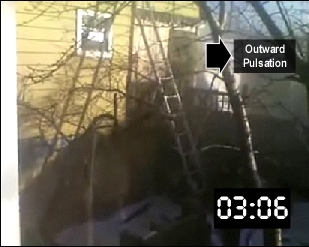
Figure 3. Conditions at 03:08 Minutes Elapsed Time in the Video Clip

Building, Smoke, Heat and Flame indicators remain the same, but several more pulsations (03:05-03:13) providing a continuing, and more significant indication of ventilation controlled, decay stage fire conditions.
What indicators can be observed at the door while the firefighter attempts to remove the covering over the window adjacent to the door on Floor 1 (03:13-13:44)?
No significant change in Building, Heat, or Flame Indicators. However, smoke from the doorway has darkened considerably and there is a pronounced pulsation as the firefighter on the ladder climbs to Floor 2 (03:26). It is important to note that some of the smoke movement observed in the video clip is fire induced, but that exterior movement is also significantly influenced by wind.
What B-SHAF indicators do you observe at the window on Floor 2 prior to breaking the glass (03:44)?
Figure 4. Conditions at 03:43 Minutes Elapsed Time in the Video Clip

The window on Floor 2 is intact and appears to be tight as there is no smoke visible on the exterior. It is difficult to tell due to the angle from which the video was shot (and reflection from daylight), but it would be likely that the firefighter on the ladder could observe condensed pyrolizate on the window and smoke logging on Floor 2. It is interesting to note limited smoke discharge from the top of the door and window on Floor 1 in the brief period immediately prior to breaking the window on Floor 2.
What indicators are observed at the window on Floor 2 immediately after breaking the glass (03:44-03:55)?
Figure 5. Conditions at 03:52 Minutes Elapsed Time in the Video Clip
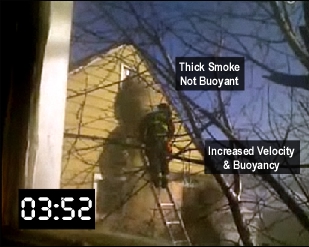
No significant changes in Building, Heat, or Flame indicators. Dark gray smoke with no buoyancy issues from the window on Floor 2 with low to moderate velocity immediately after the window is broken.
What B-SAHF indicators were present after the ventilation of the window on Floor 2 Side C was completed and 04:08 in the video clip (03:44-04:08)?
Buoyancy and velocity both increase and a slight pulsing air track develops within approximately 10 seconds. In addition, the air track at the door on Floor 1 shifts from predominantly outward with slight pulsations to predominantly inward, but with continued pulsation (possibly due to the limited size of the window opening on Floor 2, Side C.
Anticipating Potential Fire Behavior
Unlike the firefighters in Chicago who were operating at this incident, we can hit the pause button and consider the indicators observed to this point. Think about what fire behavior indicators are present (and also consider those that are not!).
Initial observations indicated a ventilation controlled decay stage fire and predicted fire behavior is an increase in heat release rate with potential for some type of extreme fire behavior. Possibilities include ventilation induced flashover (most likely) or backdraft (less likely), or smoke explosion (less likely than some type of ventilation induced extreme fire behavior).
Take a minute to review the indicators of ventilation controlled, decay stage fires as illustrated in Table 1.
Table 1. Key Fire Behavior Indicators-Ventilation Controlled, Decay Stage Fires
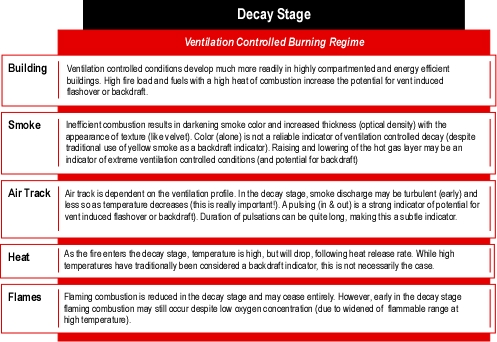
Which of these indicators were present on Side C of 4855 S. Paulina Street?
Building: The building appeared to be unremarkable, a typical single family dwelling. However, most residential structures have more than enough of a fuel load to develop the conditions necessary for a variety of extreme fire behavior phenomena.
Smoke: The dark smoke with increasing thickness (optical density) is a reasonably good indicator of ventilation controlled conditions (particularly when combined with air track indicators). Lack of buoyancy indicated fairly low temperature smoke, which could be an indicator of incipient or decay stage conditions or simply distance from the origin of the fire. However, combined with smoke color, thickness, and air track indicators, this lack of buoyancy at all levels on Side C is likely an indicator of dropping temperature under decay stage conditions. This conclusion is reinforced by the increase in buoyancy after ventilation of the window on Floor 2 (increased ventilation precipitated increased heat release rate and increasing temperature).
Air Track: Pulsing air track, while at times quite subtle and masked by swirling smoke as a result of wind, is one of the strongest indications of ventilation controlled decay stage conditions. While often associated with backdraft, this indicator may also be present prior to development of a sufficient concentration of gas phase fuel (smoke) to result in a backdraft.
Heat: Velocity of smoke discharge (air track) and buoyancy (smoke) are the only two heat indicators visible in this video clip. As discussed in conjunction with smoke indicators, low velocity and initial lack of buoyancy which increases after ventilation is indicative of ventilation controlled, decay stage conditions.
Flame: Lack of visible flame is often associated with ventilation controlled decay and backdraft conditions. However, there are a number of incidents in which flames were visible prior to occurrence of a backdraft (in another compartment within the structure). Lack of flames must be considered in conjunction with the rest of the fire behavior indicators. In this incident, lack of visible flames may be related to the stage of fire development, but more likely is a result of the location of the fire, as there is no indication that flames were present on Side C prior to the start of the video clip.
What Happened?
Firefighters had entered the building for fire attack while as illustrated in the video clip, others were ventilating windows on Side C. It is difficult to determine from the video if a window or door at the basement level on Side C was opened, but efforts were made to do so. A window on Floor 2 had been opened and firefighters were in the process of removing the covering (plywood) from a window immediately adjacent to the door on Floor 1. At 04:12, an explosion occurred, injuring two firefighters on the interior as well as the two firefighters engaged in ventilation operations on Side C.
Starting at approximately 03:59, velocity of smoke discharge from the window on Floor 2 Side C increases dramatically. At 04:08 discharge of smoke begins to form a spherical pattern as discharged from the window. This pattern becomes more pronounced as the sphere of smoke is pushed away from the window by increasing velocity of smoke discharge at 04:12, immediately prior to the explosion. Velocity of smoke discharge at the door increases between 03:59 and -4:12 as well, but as the opening is larger, this change is less noticeable. As pressure increases rapidly during the explosion a whooshing sound can be heard. After the explosion, there was no noticeable increase in fire growth.
Figure 6. Conditions at 04:08 Minutes Elapsed Time in the Video Clip
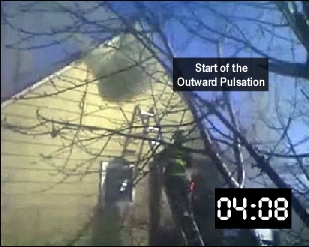
Figure 7. Conditions at 04:09 Minutes Elapsed Time in the Video Clip
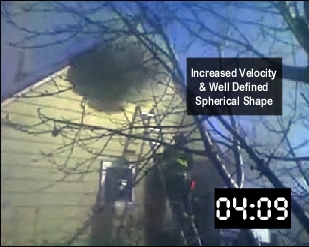
Figure 8. Conditions at 04:10 Minutes Elapsed Time in the Video Clip

Figure 9. Conditions at 04:11 Minutes Elapsed Time in the Video Clip

Figure 10. Conditions at 04:12 Minutes Elapsed Time in the Video Clip
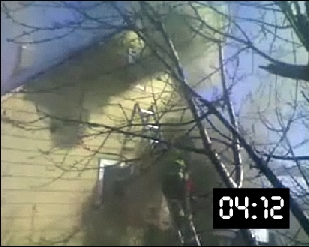
Figure 11. Conditions at 04:13 Minutes Elapsed Time in the Video Clip
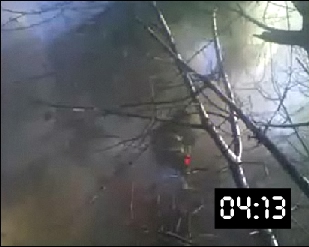
Based on observation of fire behavior indicators visible in the video clip, we know that a transient extreme fire behavior event occurred while a crew was advancing a hoseline on the interior and ventilation operations were being conducted on Side C. What we donít know is what firefighting operations were occurring on the other sides of the building or in the interior. In addition, we do not have substantive information from the fire investigation that occurred after the fire was extinguished.
The Ontology of Extreme Fire Behavior presented in an earlier post classifies these types of phenomena on the basis of outcome and conditions. As a transient and explosive event, this was likely a backdraft or smoke explosion. In that this occurred following entry and during ongoing ventilation operations, I am inclined to suspect that it was a backdraft.
Indicators visible on Side C provided a subtle warning of potential for some type of ventilation induced extreme fire behavior, but were likely not substantially different from conditions observed at many fires where extreme fire behavior did not occur.
As the title of the wildland firefighting course S133 states; Look Up, Look Down, Look Around! Anticipation of fire development and extreme fire behavior requires not only recognition of key indicators, but that these indicators be viewed from a holistic perspective. Firefighters and/or officers performing a single task or tactical assignment may only see part of the picture. It is essential that key indicators be communicated to allow a more complete picture of what is occurring and what may occur as incident operations progress.
Ed Hartin, MS, EFO, MIFireE, CFO
Tags: B-SAHF, backdraft, burning regime, deliberate practice, Extreme Fire Behavior, FBI, fire behavior, fire behavior indicators, firefighter injury, near miss, reading the fire, situational awareness, smoke explosion, vent controlled fire


